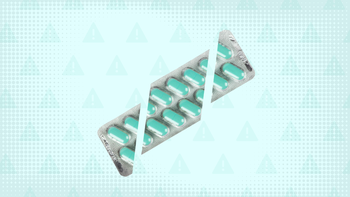
Alcohol, Paxlovid, and More: 14 Quetiapine (Seroquel) Interactions to Watch Out For
Key takeaways:
Quetiapine (Seroquel) is an atypical antipsychotic medication used to treat schizophrenia and bipolar disorder. The extended-release form (Seroquel XR) also treats depression in combination with antidepressants.
Many medications, supplements, and beverages interact with quetiapine. Examples include carbamazepine (Tegretol), St. John’s wort, and alcohol. Other medications that can cause quetiapine interactions include Paxlovid (nirmatrelvir / ritonavir), rifampin (Rifadin), and metoclopramide (Reglan).
It’s important to talk to your healthcare team about any prescription medications, over-the-counter products, or supplements you’re taking in advance. This will help them check for potential quetiapine interactions.
Table of contents

Quetiapine (Seroquel) is an atypical antipsychotic. It comes as an immediate-release (IR) and extended-release (ER) tablet (Seroquel XR). Both forms are FDA approved to treat schizophrenia and bipolar disorder. The ER form is also approved to treat depression in combination with antidepressants.
Quetiapine works by affecting the levels of certain neurotransmitters (chemical messengers) in the brain called dopamine and serotonin. And it’s metabolized (broken down) by specific enzymes (proteins) in the liver. Other medications, supplements, and even beverages that affect these processes can cause interactions with quetiapine.
Here, we’ll take a look at 14 quetiapine interactions in detail and discuss which combinations should be avoided and which may be safe.
Quetiapine interactions summary
The chart below provides a list of medications and substances that can interact with quetiapine.
| Type of medication or substance | Examples | Interaction summary |
|---|---|---|
| Some seizure medications | Carbamazepine (Tegretol) and phenytoin (Dilantin) | Decreases quetiapine blood levels, making it less effective |
| Over-the-counter supplements | St John’s wort | |
| Some antibiotics | Clarithromycin and rifampin (Rifadin) | Affects quetiapine blood levels, making side effects more likely or making quetiapine less effective |
| Oral azole antifungals | Ketoconazole and itraconazole (Sporanox) | Increases quetiapine blood levels, making side effects more likely |
| Some antivirals | Medications containing cobicistat (Tybost) or ritonavir (Norvir), such as Paxlovid (nirmatrelvir / ritonavir) | |
| Grapefruit | Large amounts of grapefruit or grapefruit juice | |
| Medications that decrease dopamine | Metoclopramide (Reglan) | Decreases dopamine levels too much in the body, causing movement problems |
| Some antihistamines | Diphenhydramine (Benadryl, ZzzQuil) and doxylamine (Unisom SleepTabs) | Increases drowsiness |
| Alcohol | Beer, wine, and spirits | |
| Muscle relaxers | Cyclobenzaprine (Amrix) and tizanidine (Zanaflex) | |
| Sleep medications | Zolpidem (Ambien) and eszopiclone (Lunesta) | |
| Gabapentinoids | Gabapentin (Neurontin) | |
| Blood pressure medications | Hydrochlorothiazide (Microzide) and lisinopril (Zestril) | Decreases blood pressure levels too much |
| Anticholinergics | Benztropine (Cogentin) and oxybutynin (Ditropan) | Increases the severity of side effects, such as constipation and urinary retention |
| Medications that cause long QT syndrome | Amiodarone (Pacerone) | Increases the risk of long QT syndrome |
| Parkinson’s disease medications | Sinemet (levodopa / carbidopa) | Decreases effectiveness of Parkinson’s medication |
This isn’t a complete list of quetiapine interactions. So be sure to give your healthcare team a list of your current medications before starting quetiapine treatment. This will help them check for possible drug interactions.
1. Phenytoin
Phenytoin is a medication that treats seizures. It can interact with enzymes that metabolize quetiapine, making quetiapine leave the body faster. This can decrease quetiapine levels in the blood, making it less effective.
If you need to take both quetiapine and phenytoin, you’ll likely need a higher dosage of quetiapine. But if you stop taking phenytoin, your prescriber may decrease your quetiapine dosage over the course of a couple weeks.
2. Carbamazepine
Carbamazepine is another anti-seizure medication. Like phenytoin, carbamazepine can make quetiapine leave the body faster and make it less effective.
If you need to take carbamazepine and quetiapine, your prescriber may increase your quetiapine dosage. But if you stop taking carbamazepine, you may need a lower quetiapine dosage. Always be sure to tell your prescriber(s) if you start or stop taking a new medication so they can make necessary adjustments.
3. Some antibiotics, such as rifampin
Rifampin is an antibiotic used to treat tuberculosis. It’s also used to help prevent meningitis. Rifampin can cause quetiapine to leave your body more quickly, making it less effective. If you need to take both medications, you’ll likely need a higher quetiapine dosage. But if you stop taking rifampin, you may need a lower quetiapine dosage.
Don’t expect to see results right away: Quetiapine (Seroquel) may start working in a couple of weeks, but it usually takes 2 to 3 months to feel the medication’s full effects.
Alcohol and quetiapine don’t mix: Taking quetiapine with alcohol can intensify the medication’s side effects, such as dizziness and drowsiness, and worsen your health condition.
Quetiapine side effects: Learn about common but often manageable quetiapine side effects from experts.
The antibiotic clarithromycin can have the opposite effect. Clarithromycin can slow the breakdown of quetiapine, making quetiapine stay in your body longer. This increases the risk of quetiapine side effects, such as headaches, constipation, and sleepiness. If you’re taking both medications, you’ll likely need a lower dosage of quetiapine until you’ve finished your round of clarithromycin.
4. Oral azoles, such as ketoconazole
Oral ketoconazole, itraconazole, and voriconazole (Vfend) are antifungal medications that treat different types of fungal infections. They can slow the breakdown of quetiapine, causing quetiapine to build up in the body. This increases the risk of quetiapine side effects.
If you have a fungal infection while taking quetiapine, your healthcare professional may recommend a different type of antifungal. But if you need to take an oral azole, you’ll likely require a lower quetiapine dosage. Once your infection is treated and you stop taking the azole, you may need to increase your quetiapine dosage. But don’t do this without talking to your prescriber first.
Ketoconazole and some other azoles come in both oral and topical versions like creams, foams, etc. Only the oral forms interact with quetiapine. Topical azoles are not absorbed enough by the body to cause an interaction.
5. Some antivirals, such as ritonavir and cobicistat
Antivirals are used to treat viral infections, including COVID-19 and HIV. Some antivirals can slow the breakdown of quetiapine, causing it to build up in the body. This makes experiencing side effects more likely.
Examples of antivirals that may interact with quetiapine in this way include ritonavir, cobicistat, and nelfinavir. Keep in mind these medications are also part of several combination antiviral pills. Examples include Paxlovid, which treats COVID, and the HIV medication Kaletra (lopinavir / ritonavir).
If you’re taking an antiviral medication, let your healthcare team know before starting quetiapine. They may lower your quetiapine dosage to prevent side effects.
6. St. John’s wort
St. John’s wort is an over-the-counter herbal supplement that some people take to help treat depression. Like some of the medications discussed above, St. John’s wort can cause quetiapine to leave your body more quickly, making it less effective.
If you’re taking St. John’s wort for depression, let your prescriber know. They may recommend that you stop taking the supplement and try an antidepressant instead.
7. Grapefruit juice
Grapefruit juice is notorious for interacting with medications. This tangy beverage blocks the enzyme that metabolizes quetiapine, increasing blood levels of the medication. This raises the risk of side effects.
If you’re a regular consumer of grapefruit or grapefruit juice, you may have to cut back while taking quetiapine. Ask your healthcare professional if they can recommend a safe amount of the citrus fruit for you to enjoy.
8. Alcohol
Drinking alcohol can cause changes to brain chemistry. This can worsen the symptoms of schizophrenia, bipolar disorder, and depression. It can also worsen common side effects of quetiapine, such as drowsiness and dizziness.
There’s some evidence that having a history of alcohol use disorder may decrease the effectiveness of medications like quetiapine. A study involving people with schizophrenia found a reduced response to the medication among participants. While this study focused on schizophrenia, it’s possible that the results could apply to other mental health conditions.
Before taking quetiapine, let your prescriber know if you drink alcohol — even occasionally — so they can evaluate your individual risks.
9. Metoclopramide
Metoclopramide is used to treat severe acid reflux and delayed stomach emptying. Both metoclopramide and quetiapine block the effects of dopamine in the brain. If you take them together, your dopamine levels can drop too low. Lower dopamine activity can cause movement-related side effects, including tardive dyskinesia. In rare cases, it can lead to a serious condition called neuroleptic malignant syndrome.
Because of the increased risk of these side effects, it’s not recommended to take metoclopramide and quetiapine together.
10. Medications that cause drowsiness, such as gabapentin and alprazolam
Drowsiness, or sleepiness, is a common side effect of quetiapine. Drowsiness can affect your ability to concentrate or think quickly in certain situations.
You’re more likely to experience drowsiness if you combine quetiapine with other medications that can also make you feel sleepy. Examples include:
Certain antihistamines, such as diphenhydramine
Sleep medications, such as zolpidem
Opioids, such as tramadol
Benzodiazepines, such as alprazolam
Muscle relaxers, such as cyclobenzaprine
Gabapentinoids, such as gabapentin
Let your prescriber know about all of the medications you take before starting quetiapine. Taking any medication that causes drowsiness with quetiapine can make you feel more tired than usual. So if taking one of these medications with quetiapine is necessary, avoid driving or doing other attention-oriented tasks until you know how quetiapine will affect you. Your prescriber may also need to change the dosage of one or more of your medications to manage this interaction.
11. Blood pressure medications
Quetiapine can cause your blood pressure levels to drop. This may be more likely if you’re changing positions quickly, like going from sitting to standing.
Your risk for low blood pressure with quetiapine may also be greater if you’re currently taking medication to treat high blood pressure or have a heart condition. Examples of blood pressure medications include hydrochlorothiazide, amlodipine (Norvasc), and lisinopril.
Your prescriber may ask you to check your blood pressure regularly at home to make sure it’s not too low. If your blood pressure is decreasing too much, they may recommend lowering the dose of your blood pressure medication(s). They may also suggest adjusting your quetiapine dosage.
12. Anticholinergic medications, such as oxybutynin
Anticholinergics are a broad group of medications that treat many different medical conditions. They work by blocking a chemical in the body called acetylcholine. Despite their different uses, the medications in this class share several possible side effects, such as:
Dry mouth, skin, and eyes
Trouble peeing
Constipation
Sweating less
Quetiapine isn’t considered an anticholinergic medication, but it can cause anticholinergic side effects, especially at higher dosages. If you take an anticholinergic medication with quetiapine, these side effects — like constipation or dry mouth — may worsen. Here are some examples of anticholinergic medications that can have this effect:
Overactive bladder medications, such as oxybutynin
Nausea medications, such as scopolamine (Transderm Scop)
Movement disorder medications, such as benztropine
Irritable bowel syndrome medications, such as dicyclomine (Bentyl)
Before taking quetiapine, ask your healthcare team to review a list of the other medications you take, including over-the-counter products. They can let you know if you’re at greater risk of anticholinergic side effects.
13. Medications that can cause arrhythmia, such as amiodarone
Long QT syndrome is a type of arrhythmia (abnormal heart rhythm). It can be present at birth, or it can be caused by electrolyte imbalances or medications. Long QT syndrome can be life-threatening if left untreated.
Quetiapine, and other antipsychotics, can cause long QT syndrome. Your risk increases if you take it along with other medications that can also cause long QT syndrome. Examples include:
Macrolide antibiotics, such as azithromycin (Zithromax)
Fluoroquinolone antibiotics, such as ciprofloxacin (Cipro)
Some selective serotonin reuptake inhibitors (SSRIs), such as citalopram (Celexa) and escitalopram (Lexapro)
Antiarrhythmics, such as amiodarone
Fluconazole (Diflucan)
Before starting quetiapine treatment, give your healthcare team a list of all the medications you take so they can assess your risk for long QT syndrome. Additionally, let them know your full health history, as some health conditions (like low potassium or magnesium levels) can make long QT syndrome more likely.
14. Parkinson’s disease medications, such as Sinemet
Dopamine agonists are a group of medications that treat Parkinson’s disease. They work by increasing dopamine in the body. Examples include Sinemet, ropinirole, and pramipexole.
Quetiapine, and many other antipsychotics, lower dopamine levels in the brain. So taking quetiapine with a dopamine agonist can make the Parkinson’s treatment less effective. If you’re taking one of these medications, let your prescriber know before starting treatment with quetiapine.
The bottom line
Quetiapine (Seroquel, Seroquel XR) is a medication that treats schizophrenia, bipolar disorder, and depression. But it can interact with many medications and some foods and supplements. Examples of medications and substances that can cause quetiapine interactions include: carbamazepine (Tegretol), rifampin (Rifadin), Paxlovid (nirmatrelvir / ritonavir), St. John’s wort, alcohol, and grapefruit juice. And these are just a few examples.
Quetiapine interactions can cause a greater risk of side effects, make quetiapine less effective, or make the interacting medication less effective. So have an open conversation with your healthcare team about your dietary habits and all of the medications, supplements, and over-the-counter products you take. They can use this information to help you avoid or manage quetiapine interactions.
Why trust our experts?



References
Coupler. (2024). Quetiapine fumarate - quetiapine tablet [package insert].
Lynch, T., et al. (2007). The effect of cytochrome P450 metabolism on drug response, interactions, and adverse effects. American Family Physician.
Maan, J. S., et al. (2023). Quetiapine. StatPearls.
Muench, J., et al. (2010). Adverse effects of antipsychotic medications. American Family Physician.
Negrete, J. C. (2004). History of alcohol abuse reduces response to antipsychotics in people with first episode psychosis. BMJ Mental Health.
Patel., P. H., et al. (2023). Macrolides. StatPearls.
PD-Rx Pharmaceuticals. (2024). Ketoconazole - ketoconazole tablet [package insert].
RemedyRepack. (2024). Dilantin - extended phenytoin sodium capsule [package insert].
Was this page helpful?
Related Articles
Browse medications
View AllResearch prescriptions and over-the-counter medications from A to Z, compare drug prices, and start saving.






















